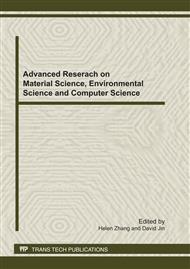p.189
p.195
p.201
p.205
p.209
p.213
p.219
p.224
p.230
Fabrication of Self-Organized TiO2 Nanotubes by Anodization and its Photocatalytic Properties
Abstract:
Titania nanotube arrays(TNT) was extensively studied due to its good photocatalytic activity. This article focused on the fabrication of highly ordered TNTs. TNTs were fabricated in an electrolyte of ethylene glycol(EG), water and NH4F for 1, 2, 3, 4h and then annealed at 400°C. The influence of anodic time on the morphology and photocatalytic performance of TNT was investigated. The results indicated that the TNT could be successfully fabricated by using the electrolyte, and the diameter and length of TNT were about approximately 140nm, 5-13μm, separately. Furthermore, the results also showed anatase phase was dominant, TNT with good morphology displayed good photocatalitic properties. When the initial concentration of Rhodamine B(RhB) was 7×10−6mol﹒L−1, the removal of RhB reached 88.1% by TNT anodized for 2h with length of 9.5μm. In addition, the results showed that the photocatalytic reaction fitting the first-order reaction in good agreement with the literature, and the apparent rate constant(kapp) was 0.0251 min-1(the length of 9.5μm).
Info:
Periodical:
Pages:
209-212
Citation:
Online since:
August 2011
Authors:
Price:
Сopyright:
© 2011 Trans Tech Publications Ltd. All Rights Reserved
Share:
Citation:


